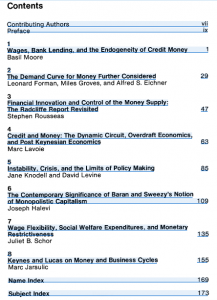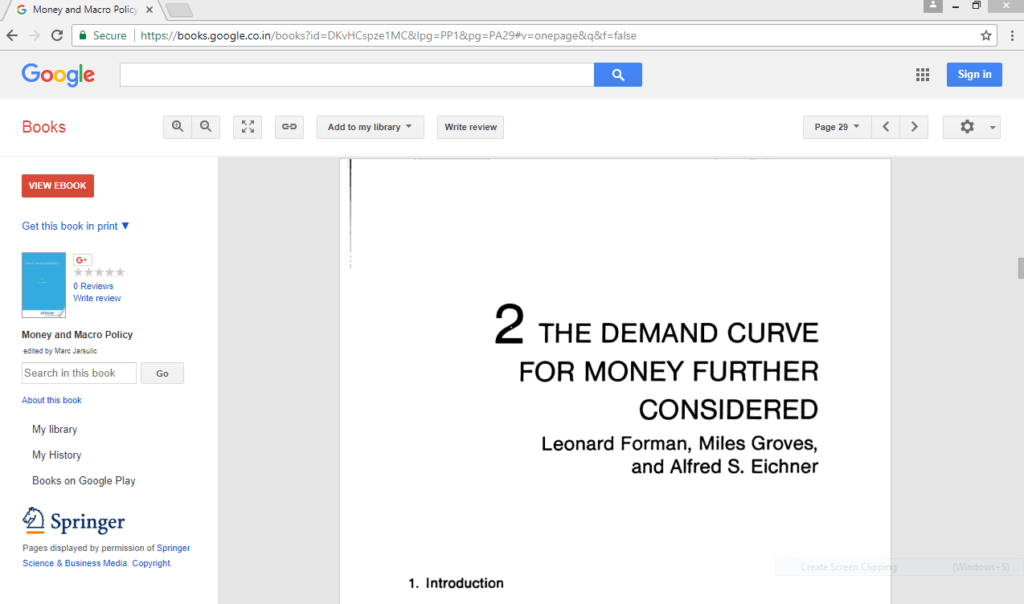Alfred Eichner was a Post-Keynesian economist known for his text Macrodynamics of Advanced Market Economies published 3 years after his death in 1988. He died at the age of 50 in an accident and at the time he was preparing to include an analysis of open economy macroeconomics in his story of how economies work.

Google Books allows a preview of the chapter and embedding it on a webpage and I have done so at the end of this post. If it doesn’t appear properly in your browser, please let me know. Else, like me, you can buy the book 🙂 Of course G-books won’t allow a preview of all pages due to copyright restrictions.
Eichner’s chapter (#2) is titled The Demand Curve For Money Further Considered.
The authors start off the description with
First, the amount of bank reserves, and thus the monetary base, is not the exogenously determined variable assumed in both orthodox Keynesian and monetarist models but instead depends on the level of nominal income. This is because the central bank, in order to maintain the liquidity of the financial system, is forced to purchase government securities in the open market so as to accommodate, at least in part, the need for additional credit as the pace of economic activity quickens. With the amount of unborrowed bank reserves, and thus the monetary base, to a significant extent endogenously determined, it follows that the money supply is, to no less an extent endogenously determined as well. It is therefore a misspecification to assume that the money stock, or any of its components, is entirely exogenous, subject to the control of the monetary authorities, and then to derive a demand curve for money based on that assumption. In reality, the demand for and supply of “money” are interdependent, with no possibility in practice of being able to distinguish between the two.
Second, it is the demand for credit rather than the demand for money which is the necessary starting point for analyzing the role played by monetary factors in determining the level of real economic activity…
The authors then point out the neutralizing nature of open-market operations of the Fed. Usually this – open market operations – is presented in textbooks and in some old Federal Reserve publications as causing the amount of reserves to rise and allowing banks to increase the supply of reserves. Eichner had earlier worked with data and failed to see open market operations increasing the amount of reserves in practice. He realized that the open market operations neutralize flows:
… Thus, in the face of a fluctuating public demand for currency, flows of gold into and out of the country, variations in the amount of deposits held at the Fed by foreigners and others, changes in the amount of float and fluctuations in the Treasury’s cash holdings, the Fed must engage in open-market operations just to maintain bank reserves at a given level. This is the neutralizing component of a fully accommodating policy, and it is one reason why it is difficult in practice to relate change in bank reserves to open market operations …
What is so nice about the quote above is that Eichner knew exactly what factors affect reserve balances. At the time, “float” may have been more important than it is today. Eichner not only knew that the Treasury’s account at the Fed affects reserve balances but also holdings of other institutions such as foreign central banks – i.e., as a result of “flows of funds into or out of the Federal Reserve System” in his own words. (In the same paragraph from which the quote is taken).
Further the article goes:
An increase in the demand for credit will, to the extent it is satisfied, lead to an increase in bank deposits (especially demand deposits). This is because banks make loans by simply crediting the borrower’s account at the bank with the funds advanced. The increase in deposits will, however, require that banks maintain larger reserves at the Fed. Thus required reserves, ResR, will increase and, unless the Fed acts through the purchase of government securities in the open market to provide banks with the necessary additional reserves, banks will find themselves with insufficient reserves to meet their legal requirements… the Fed is forced to accommodate, at least in part, whatever demand for credit may manifest itself.
The terminology “accommodating” was later made clear later by Eichner in his book Macrodynamics as operations aimed at pegging the short term interest rate whatever the economic or credit conditions. So when the Fed is not accommodating – in this terminology – it means it is pursuing a policy of raising rates at frequent intervals with an aim to impact credit and aggregate demand.
The Google Books link is embedded below.
click to view on Google Books
Endnote
*Chief Economist and Economic Analyst, respectively at The New York Times at the time of writing.
